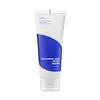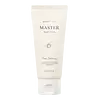What's inside
What's inside
 Key Ingredients
Key Ingredients

 Benefits
Benefits

 Concerns
Concerns

 Ingredients Side-by-side
Ingredients Side-by-side

Water
Skin ConditioningGlycerin
HumectantHydrogenated Polydecene
EmollientCaprylic/Capric Triglyceride
MaskingDipropylene Glycol
HumectantCyclohexasiloxane
EmollientButyrospermum Parkii Butter
Skin ConditioningPolyglyceryl-3 Methylglucose Distearate
EmulsifyingCetyl Alcohol
EmollientGlycereth-26
HumectantGlyceryl Stearate
EmollientBetaine
HumectantBehenyl Alcohol
EmollientVinyldimethicone
Pentylene Glycol
Skin ConditioningLaminaria Japonica Extract
Skin ProtectingEclipta Prostrata Leaf Extract
Skin ConditioningAvena Sativa Kernel Extract
AbrasiveCynara Scolymus Leaf Extract
Skin ConditioningPrunus Armeniaca Kernel Oil
MaskingArgania Spinosa Kernel Oil
EmollientCarthamus Tinctorius Seed Oil
MaskingSodium Hyaluronate
HumectantHydrogenated Lecithin
EmulsifyingCamellia Sinensis Leaf Water
MaskingPolyglyceryl-10 Laurate
Skin ConditioningPentaerythrityl Distearate
EmulsifyingAmmonium Acryloyldimethyltaurate/Vp Copolymer
Glyceryl Caprylate
EmollientSodium Stearoyl Glutamate
CleansingMethylpropanediol
SolventFructooligosaccharides
HumectantDisodium EDTA
Beta-Glucan
Skin ConditioningHydrolyzed Hyaluronic Acid
HumectantPolyquaternium-51
Skin ConditioningButylene Glycol
HumectantHydroxypropyltrimonium Hyaluronate
Dimethylsilanol Hyaluronate
HumectantHydrolyzed Sodium Hyaluronate
Skin ConditioningPotassium Hyaluronate
Skin ConditioningHyaluronic Acid
HumectantSodium Hyaluronate Crosspolymer
HumectantSodium Acetylated Hyaluronate
HumectantSodium Hyaluronate Dimethylsilanol
Humectant1,2-Hexanediol
Skin ConditioningHydroxyacetophenone
AntioxidantEthylhexylglycerin
Skin ConditioningWater, Glycerin, Hydrogenated Polydecene, Caprylic/Capric Triglyceride, Dipropylene Glycol, Cyclohexasiloxane, Butyrospermum Parkii Butter, Polyglyceryl-3 Methylglucose Distearate, Cetyl Alcohol, Glycereth-26, Glyceryl Stearate, Betaine, Behenyl Alcohol, Vinyldimethicone, Pentylene Glycol, Laminaria Japonica Extract, Eclipta Prostrata Leaf Extract, Avena Sativa Kernel Extract, Cynara Scolymus Leaf Extract, Prunus Armeniaca Kernel Oil, Argania Spinosa Kernel Oil, Carthamus Tinctorius Seed Oil, Sodium Hyaluronate, Hydrogenated Lecithin, Camellia Sinensis Leaf Water, Polyglyceryl-10 Laurate, Pentaerythrityl Distearate, Ammonium Acryloyldimethyltaurate/Vp Copolymer, Glyceryl Caprylate, Sodium Stearoyl Glutamate, Methylpropanediol, Fructooligosaccharides, Disodium EDTA, Beta-Glucan, Hydrolyzed Hyaluronic Acid, Polyquaternium-51, Butylene Glycol, Hydroxypropyltrimonium Hyaluronate, Dimethylsilanol Hyaluronate, Hydrolyzed Sodium Hyaluronate, Potassium Hyaluronate, Hyaluronic Acid, Sodium Hyaluronate Crosspolymer, Sodium Acetylated Hyaluronate, Sodium Hyaluronate Dimethylsilanol, 1,2-Hexanediol, Hydroxyacetophenone, Ethylhexylglycerin
Centella Asiatica Extract
CleansingWater
Skin ConditioningGlycerin
HumectantPanthenol
Skin ConditioningSodium Hyaluronate
HumectantMadecassoside
AntioxidantHydrolyzed Hyaluronic Acid
HumectantCeramide NP
Skin ConditioningHyaluronic Acid
HumectantPhytosphingosine
Skin ConditioningTocopherol
AntioxidantAsiaticoside
AntioxidantTocopheryl Acetate
AntioxidantSodium Hyaluronate Crosspolymer
HumectantHydrolyzed Glycosaminoglycans
HumectantSodium Acrylate/Sodium Acryloyldimethyl Taurate Copolymer
Emulsion StabilisingButylene Glycol
HumectantAcrylates/C10-30 Alkyl Acrylate Crosspolymer
Emulsion StabilisingArginine
MaskingDimethicone
EmollientPolyisobutene
Hydrogenated Polydecene
EmollientCetyl Ethylhexanoate
EmollientCaprylyl Glycol
EmollientPentylene Glycol
Skin ConditioningEthylhexylglycerin
Skin ConditioningCaprylyl/Capryl Glucoside
CleansingSorbitan Oleate
EmulsifyingDisodium EDTA
Limnanthes Alba Seed Oil
Skin ConditioningHelianthus Annuus Seed Oil
EmollientPropanediol
SolventRosa Canina Fruit Oil
EmollientArgania Spinosa Kernel Oil
EmollientCanola Oil
EmollientPolyglyceryl-10 Stearate
Skin ConditioningHexyldecanol
EmollientBenzyl Glycol
SolventSimmondsia Chinensis Seed Oil
EmollientHydrogenated Lecithin
EmulsifyingDextrin
AbsorbentCetearyl Alcohol
EmollientCentella Asiatica Extract, Water, Glycerin, Panthenol, Sodium Hyaluronate, Madecassoside, Hydrolyzed Hyaluronic Acid, Ceramide NP, Hyaluronic Acid, Phytosphingosine, Tocopherol, Asiaticoside, Tocopheryl Acetate, Sodium Hyaluronate Crosspolymer, Hydrolyzed Glycosaminoglycans, Sodium Acrylate/Sodium Acryloyldimethyl Taurate Copolymer, Butylene Glycol, Acrylates/C10-30 Alkyl Acrylate Crosspolymer, Arginine, Dimethicone, Polyisobutene, Hydrogenated Polydecene, Cetyl Ethylhexanoate, Caprylyl Glycol, Pentylene Glycol, Ethylhexylglycerin, Caprylyl/Capryl Glucoside, Sorbitan Oleate, Disodium EDTA, Limnanthes Alba Seed Oil, Helianthus Annuus Seed Oil, Propanediol, Rosa Canina Fruit Oil, Argania Spinosa Kernel Oil, Canola Oil, Polyglyceryl-10 Stearate, Hexyldecanol, Benzyl Glycol, Simmondsia Chinensis Seed Oil, Hydrogenated Lecithin, Dextrin, Cetearyl Alcohol
 Reviews
Reviews

Ingredients Explained
These ingredients are found in both products.
Ingredients higher up in an ingredient list are typically present in a larger amount.
You may know this ingredient as argan oil. Argan Oil has antioxidant, hydrating, and soothing properties.
Studies have shown argan oil can help fight again radical damage from the sun. This makes it effective at preventing hyperpigmentation.
Large amounts of vitamin E found in argan oil helps the skin retain water. Argan oil also contains fatty acids such as linoleic acid, oleic acid, and palmitic acid. It is also a good source of lipids.
Another benefit of argan oil is skin-soothing. It can help reduce inflammation-related skin symptoms.
Argan Oil is effective at regulating sebum production in pores. This can make it effective at treating hormonal acne.
Traditionally, argan oil was used for its antibacterial and antifungal properties. However, argan oil contains fatty acids that may make it not fungal-acne safe.
Argan Trees are native to Morocco.
Learn more about Argania Spinosa Kernel OilButylene Glycol (or BG) is used within cosmetic products for a few different reasons:
Overall, Butylene Glycol is a safe and well-rounded ingredient that works well with other ingredients.
Though this ingredient works well with most skin types, some people with sensitive skin may experience a reaction such as allergic rashes, closed comedones, or itchiness.
Learn more about Butylene GlycolDisodium EDTA plays a role in making products more stable by aiding other preservatives.
It is a chelating agent, meaning it neutralizes metal ions that may be found in a product.
Disodium EDTA is a salt of edetic acid and is found to be safe in cosmetic ingredients.
Learn more about Disodium EDTAEthylhexylglycerin (we can't pronounce this either) is commonly used as a preservative and skin softener. It is derived from glyceryl.
You might see Ethylhexylglycerin often paired with other preservatives such as phenoxyethanol. Ethylhexylglycerin has been found to increase the effectiveness of these other preservatives.
Glycerin is already naturally found in your skin. It helps moisturize and protect your skin.
A study from 2016 found glycerin to be more effective as a humectant than AHAs and hyaluronic acid.
As a humectant, it helps the skin stay hydrated by pulling moisture to your skin. The low molecular weight of glycerin allows it to pull moisture into the deeper layers of your skin.
Hydrated skin improves your skin barrier; Your skin barrier helps protect against irritants and bacteria.
Glycerin has also been found to have antimicrobial and antiviral properties. Due to these properties, glycerin is often used in wound and burn treatments.
In cosmetics, glycerin is usually derived from plants such as soybean or palm. However, it can also be sourced from animals, such as tallow or animal fat.
This ingredient is organic, colorless, odorless, and non-toxic.
Glycerin is the name for this ingredient in American English. British English uses Glycerol/Glycerine.
Learn more about GlycerinHyaluronic acid is naturally found in healthy skin. It is a humectant, meaning it draws moisture to your skin.
This ingredient helps hydrate, soothe, and protect the skin.
What makes hyaluronic acid so hydrating? It has the capacity to bind or hold large amounts of water.
Fun fact: It is already naturally found in our bodies, such as the fluids of our eyes and our joints.
Studies find this ingredient to have anti-inflammatory and anti-microbial properties. This can help speed up wound-healing.
Hyaluronic acid can be irritating if the molecule has a low-molecular weight, or if the molecules are small.
One study found low-molecular weight hyaluronic acid to be pro-inflammatory, meaning some people may experience irritation. This is because our bodies use hyaluronic acid in the wound-healing process to signal to our bodies, via irritation, that something needs healing.
The same study found high-molecular weight hyaluronic acid to be anti-inflammatory.
These are some other common types of Hyaluronic Acid:
Learn more about Hyaluronic AcidHydrogenated Lecithin is created from the hydrogenation of lecithin (a group of phospholipids). Hydrogenation is a chemical reaction between hydrogen and another element.
This ingredient is an emollient and emulsifier. As an emollient, it helps soften skin by trapping moisture within. As an emulsifier, it prevents oil and water ingredients from separating.
Hydrogenated Polydecene is an emollient. It creates a non-occlusive film on the skin that offers extra protection for your skin barrier.
The texture of Hydrogenated Polydecene ranges from light and silky to rich.
Hydrogenated Polydecene is the end compound of controlled hydrogenation of Polydecene.
Learn more about Hydrogenated PolydeceneHydrolyzed Hyaluronic Acid is a form of hyaluronic acid. It is created by the hydrolysis of hyaluronic acid with a high molecular weight. Once created, Hydrolyzed Hyaluronic Acid has a low molecular weight.
Low molecular weight HA has been shown to hydrate and increase elasticity of the skin. Increasing elasticity is also associated with reduction of wrinkle depth.
One study found topical low molecular weight hyaluronic acid may be considered for the treatment of rosacea in the adult population. However, we always recommend speaking with a professional about your skin concerns.
Hyaluronic acids are a humectant. This means they draw moisture from the air. Hyaluronic acids help moisturize, soothe, and protect the skin.
Read more about other common forms of hyaluronic acid:
Learn more about Hydrolyzed Hyaluronic AcidPentylene glycol is typically used within a product to thicken it. It also adds a smooth, soft, and moisturizing feel to the product. It is naturally found in plants such as sugar beets.
The hydrophilic trait of Pentylene Glycol makes it a humectant. As a humectant, Pentylene Glycol helps draw moisture from the air to your skin. This can help keep your skin hydrated.
This property also makes Pentylene Glycol a great texture enhancer. It can also help thicken or stabilize a product.
Pentylene Glycol also acts as a mild preservative and helps to keep a product microbe-free.
Some people may experience mild eye and skin irritation from Pentylene Glycol. We always recommend speaking with a professional about using this ingredient in your routine.
Pentylene Glycol has a low molecular weight and is part of the 1,2-glycol family.
Learn more about Pentylene GlycolSodium Hyaluronate is hyaluronic acid's salt form. It is commonly derived from the sodium salt of hyaluronic acid.
Like hyaluronic acid, it is great at holding water and acts as a humectant. This makes it a great skin hydrating ingredient.
Sodium Hyaluronate is naturally occurring in our bodies and is mostly found in eye fluid and joints.
These are some other common types of Hyaluronic Acid:
Learn more about Sodium HyaluronateSodium Hyaluronate Crosspolymer is a type of hyaluronic acid. In fact, it is modified version of hyaluronic acid.
The structure of Sodium Hyaluronate Crosspolymer allows it to stay in the skin's top layer for a longer period of time. This allows for even more hydration and humectant action than hyaluronic acid.
These are some other common types of Hyaluronic Acid:
Learn more about Sodium Hyaluronate CrosspolymerWater. It's the most common cosmetic ingredient of all. You'll usually see it at the top of ingredient lists, meaning that it makes up the largest part of the product.
So why is it so popular? Water most often acts as a solvent - this means that it helps dissolve other ingredients into the formulation.
You'll also recognize water as that liquid we all need to stay alive. If you see this, drink a glass of water. Stay hydrated!
Learn more about Water